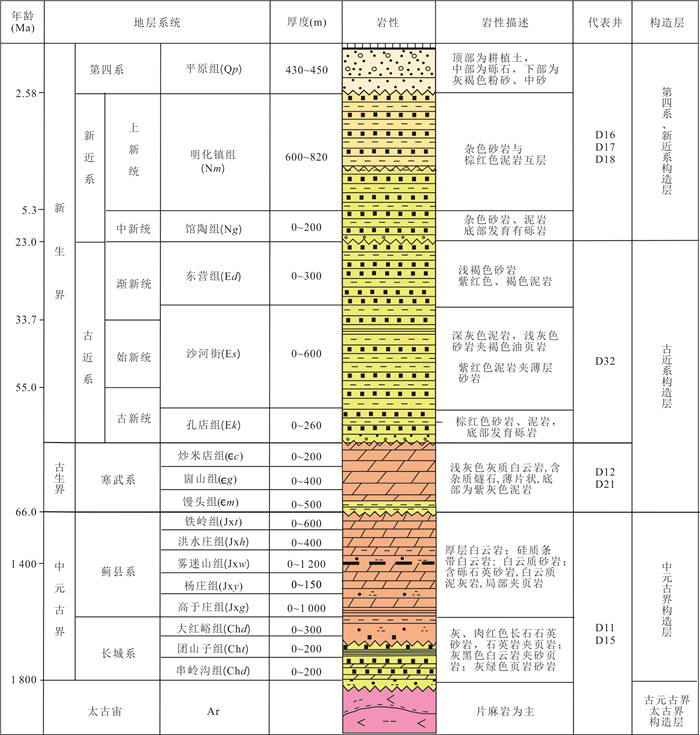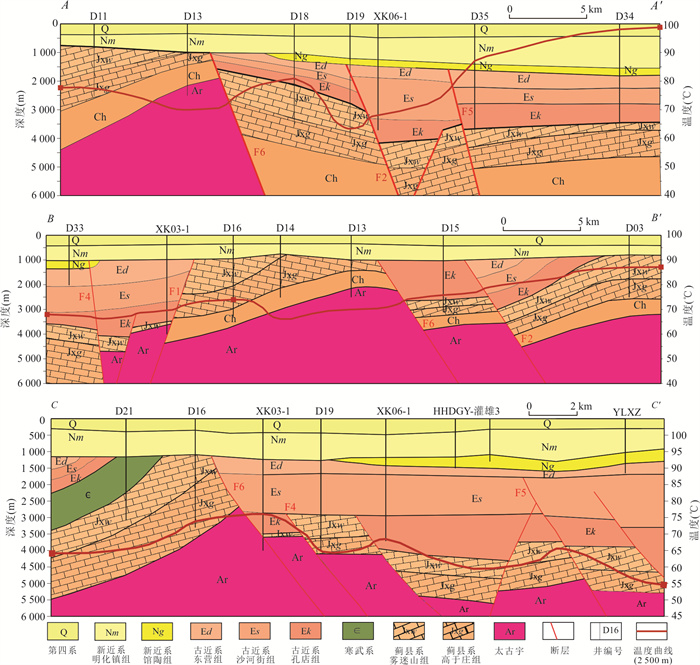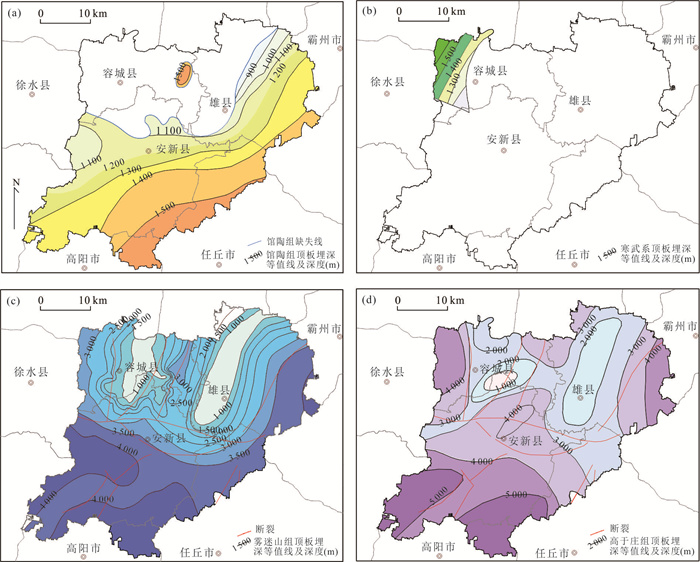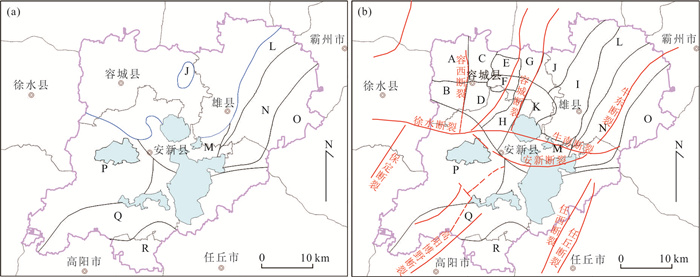Evaluation of Geothermal Resources of the Xiong'an New Area
-
摘要: 分析地热资源的形成、准确评估地热资源量是实现雄安新区地热资源可持续开发利用、推进碳中和的重要途径之一.本文通过研究雄安新区26口地热勘探井及水质分析、试采试验等数据,对地热田内馆陶组、寒武系、蓟县系雾迷山组、高于庄组热储的空间分布范围及热储特征进行了分析,采用可采系数法和采灌均衡法评价了雄安新区地热资源量.结果表明,采灌均衡法计算的可采资源量和热量远大于开采系数法.采灌均衡法更贴近实际开发条件,且可靠性经过了比拟法验证.采灌均衡条件下全区地热流体可开采资源量为401.77×106 m3/a,地热流体可开采热量为1 013.2×1014 J/a,折合标准煤346.99×104 t/a.以上研究可优化新区地热资源区划,推动“碳达峰、碳中和”目标实现.Abstract: Analysis of the formation of geothermal resources and accurate assessment of the amount of geothermal resources are of great significance for the scientific and sustainable development and utilization of geothermal resources in Xiong'an New Area and achievement of carbon neutrality. This paper analyses the spatial distribution range and geothermal reserve characteristics of Guantao Formation, Cambrian System, Wumishan Formation and Gaoyuzhuang Formation in the geothermal field by studying data from 26 geothermal exploration wells including water quality analysis and mining tests in the Xiong'an New Area, and evaluates the geothermal resources of the Xiong'an New Area using the recoverable coefficient method and the equilibrium method of extraction-reinjection. The results show that the recoverable resources and heat calculated by the balanced extraction and reinjection method are much larger than those by the extraction coefficient method. The balanced extraction and reinjection method is closer to the actual development conditions and verified by the comparison method. The recoverable resources of geothermal fluids in the whole area under the balanced extraction and reinjection conditions are 401.77×106 m3/a, and the recoverable heat of geothermal fluids is 1 013.2×1014 J/a, equivalent to 346.99×104 t standard coal/year. This study will optimise the zoning of geothermal resources in the new area and promote the achievement of goal of "carbon peaking and carbon neutrality".
-
表 1 主要计算参数
Table 1. Main calculation parameters
地层 分区 储厚比 热储温度(℃) 水位埋深(m) 岩石密度(kg/m3) 岩石比热(J/(kg·℃)) 孔隙率/裂隙率(%) 弹性释水系数(10‒5) 馆陶组 J区 0.36 50 86 2 600 879.23 30 37.67 L区 0.36 50.5 90 2 600 879.23 30 37.67 M区 0.36 50.5 90 2 600 879.23 30 37.67 N区 0.24 50.5 90 2 600 879.23 30 37.67 O区 0.36 50.5 90 2 600 879.23 30 37.67 P区 0.36 48 45 2 500 879.27 20 30.00 Q区 0.36 60 49 2 500 879.27 20 30.00 R区 0.36 68 60 2 500 879.27 20 30.00 雾迷山组 A区 0.40 70 115 2 850 877.01 3.5 2.91 B区 0.40 62 113 2 940 788.58 3.5 2.91 C区 0.30 66 114 2 833 848.32 4 3.52 D区 0.30 53 122 2 833 870.25 4 3.32 E区 0.30 60 110 2 833 1 170.63 4 1.67 F区 0.20 60 110 2 833 870.25 4 1.11 G区 0.30 75 110 2 833 870.25 3.5 3.61 H区 0.30 85 112 2 833 1 091.03 3.5 2.87 I区 0.25 80 115 2 803 1 044.18 3.5 3.89 J区 0.30 80 105 2 803 1 044.18 3.5 3.60 K区 0.30 80 100 2 803 1 044.18 3.5 3.60 L区 0.30 80 100 2 750 1 044.18 3.5 3.60 M区 0.30 80 110 2 750 1 044.18 3.5 3.60 O区 0.20 80 110 2 750 1 044.18 3.5 4.32 P区 0.18 120 125 2 870 1 309.24 3 3.28 Q区 0.16 118 120 2 870 1 309.24 3 3.28 R区 0.16 115 115 2 870 1 309.24 3 3.28 高于庄组 A区 0.15 80 115 2 850 877.01 2 0.42 B区 0.15 66 113 2 854 788.58 2 0.42 C区 0.15 70 114 2 800 856.08 2 1.04 D区 0.15 70 122 2 833 812.30 2 1.04 E区 0.20 65 110 2 833 812.30 2 1.11 F区 0.20 65 110 2 833 812.30 2 1.38 G区 0.15 85 110 2 833 812.30 2 0.62 H区 0.15 95 112 2 833 812.30 2 0.61 I区 0.15 90 115 2 814 1 055.52 2 1.02 J区 0.15 90 110 2 803 1 055.52 2 1.02 K区 0.15 90 100 2 803 1 055.52 2 1.02 L区 0.13 90 105 2 750 1 055.52 2 1.02 M区 0.15 90 115 2 750 1 055.52 2 1.02 N区 0.13 90 105 2 750 1 055.52 2 1.02 O区 0.30 90 100 2 750 1 055.52 2 2.45 寒武系 A区 0.15 76 80 2 700 982.05 3 1.32 B区 0.15 76 80 2 700 982.05 3 1.32 表 2 不同地热田资源量计算结果
Table 2. Results of resource calculations for different geothermal fields
地热田 总面积(km2) 地热资源量(1016J) 地热流体储存量(108m3) 地热流体可采量(开采系数法)(106m3/a) 地热流体可开采热量(开采系数法)(1014J/a) 地热流体可采量(采灌均衡法) (106m3/a) 地热流体可开采热量(采灌均衡法)(1014J/a) 容城 309.97 1 230.73 30.25 1.51 3.35 100.07 223.85 牛驼镇 699.11 2 062.62 124.94 6.25 11.72 141.01 356.67 高阳 628.04 2 635.31 221.50 11.08 22.79 160.69 432.68 合计 1 637.12 5 928.66 376.68 18.84 37.86 401.77 1 013.20 表 3 不同热储层资源量计算结果
Table 3. Results of resource calculations for different thermal reservoirs
地热田 总面积(km2) 地热资源量(1016J) 地热流体储存量(108m3) 地热流体可采量(开采系数法)(106m3/a) 地热流体可开采热量(开采系数法)(1014J/a) 地热流体可采量(采灌均衡法)(106m3/a) 地热流体可开采热量(采灌均衡法)(1014J/a) 馆陶组 1 026.72 1 372.69 287.93 14.40 25.31 125.38 222.17 寒武系 47.00 81.03 1.71 0.09 0.21 6.21 15.13 雾迷山组 1 637.12 3 200.15 71.05 3.56 10.09 190.92 553.44 高于庄组 925.80 1 274.80 16.00 0.80 2.25 79.26 222.45 合计 - 5 928.67 376.68 18.84 37.86 401.77 1 013.20 -
Allen, M. B., MacDonald, D. I. M., Xun, Z., et al., 1997. Early Cenozoic Two-Phase Extension and Late Cenozoic Thermal Subsidence and Inversion of the Bohai Basin, Northern China. Marine and Petroleum Geology, 14(7-8): 951-972. https://doi.org/10.1016/S0264-8172(97)00027-5 Chen, M. X., Wang, J. Y., Wang, J. A., et al., 1990. The Characteristics of the Geothermal Field and Its Formation Mechanism in the North China Down-Faulted Basin. Acta Geological Sinica, 64(1): 80-91 (in Chinese with English abstract). Cui, Y., Zhu, C. Q., Qiu, N. S., et al., 2020. Geothermal Lithospheric Thickness in the Central Jizhong Depression and Its Geothermal Significance. Acta Geologica Sinica, 94(7): 1960-1969 (in Chinese with English abstract). doi: 10.3969/j.issn.0001-5717.2020.07.005 Furlong, K. P., Chapman, D. S., 2013. Heat Flow, Heat Generation, and the Thermal State of the Lithosphere. Annual Review of Earth and Planetary Sciences, 41: 385-410. https://doi.org/10.1146/annurev.earth.031208.100051 He, D. F., Shan, S. Q., Zhang, Y. Y., et al., 2018. 3-D Geologic Architecture of Xiong'an New Area: Constraints from Seismic Reflection Data. Science in China (Series D), 48(9): 1207-1222 (in Chinese with English abstract). Hu, Q. Y., Gao, J., Ma, F., et al., 2020. Dynamic Prediction of Geothermal Recoverable Resources in the Rongcheng Uplift Area of the Xiongan New Area. Acta Geologica Sinica, 94(7): 2013-2025 (in Chinese with English abstract). doi: 10.3969/j.issn.0001-5717.2020.07.010 Kong, Y. L., Pang, Z. H., Pang, J. M., et al., 2017. Stable Isotopes of Deep Groundwater in the Xiongxian Geothermal Field. Procedia Earth and Planetary Science, 17: 512-515. https://doi.org/10.1016/j.proeps.2016.12.129 Kusky, T. M., Li, J. H., 2003. Paleoproterozoic Tectonic Evolution of the North China Craton. Journal of Asian Earth Sciences, 22(4): 383-397. https://doi.org/10.1016/S1367-9120(03)00071-3 Li, W. W., Rao, S., Tang, X. Y., et al., 2014. Borehole Temperature Logging and Temperature Field in the Xiongxian Geothermal Field, Hebei Province. Chinese Journal of Geology, 49(3): 850-863 (in Chinese with English abstract). Liu, M. L., He, T., Wu, Q. F., 2020. Hydrogeochemistry of Geothermal Waters from Xiongan New Area and Its Indicating Significance. Earth Science, 45(6): 2221-2231 (in Chinese with English abstract). Liu, Z. M., Liang, J. Y., Liu, C. L., 2016. Assessment Method of Geothermal Fluid Exploitable Reserve under Condition of Reinjection. Ground Water, 38(2): 61-63 (in Chinese with English abstract). doi: 10.3969/j.issn.1004-1184.2016.02.022 Long, X. T., Xie, H. P., Deng, X. P., et al., 2021. Geological and Geochemical Characteristics of the Geothermal Resources in Rucheng, China. Lithosphere, 2021(Special 5): 1357568. https://doi.org/10.2113/2021/1357568 Lu, K., Bao, Z. D., Ji, H. C., et al., 2019. Characteristics, Main Controlling Factors and Favorable Area Prediction of Karstic Geothermal Reservoirs of the Jixianian Wumishan Formation in Xiongan New Area. Journal of Palaeogeography, 21(6): 885-900 (in Chinese with English abstract). Lund, J. W., Boyd, T. L., 2016. Direct Utilization of Geothermal Energy 2015 Worldwide Review. Geothermics, 60: 66-93. https://doi.org/10.1016/j.geothermics.2015.11.004 Lund, J. W., Toth, A. N., 2021. Direct Utilization of Geothermal Energy 2020 Worldwide Review. Geothermics, 90: 101915. https://doi.org/10.1016/j.geothermics.2020.101915 Ma, F., Wang, G. L., Zhang, W., et al., 2020. Structure of Geothermal Reservoirs and Resource Potential in the Rongcheng Geothermal Field in Xiongan New Area. Acta Geologica Sinica, 94(7): 1981-1990 (in Chinese with English abstract). doi: 10.3969/j.issn.0001-5717.2020.07.007 Ma, X. Y., Liu, H. F., Wang, W. X., et al., 1983. Meso-Cenozoic Taphrogeny and Extensional Tectonics in Eastern China. Acta Geological Sinica, 57(1): 22-32 (in Chinese with English abstract). Mao, X. P., Wang, X. W., Li, K. W., et al., 2018. Sources of Heat and Control Factors in Geothermal Field. Earth Science, 43(11): 4256-4266 (in Chinese with English abstract). Qiu, N. S., Xu, W., Zuo, Y. H., et al., 2017. Evolution of Meso-Cenozoic Thermal Structure and Thermal-Rheological Structure of the Lithosphere in the Bohai Bay Basin, Eastern North China Craton. Earth Science Frontiers, 24(3): 13-26 (in Chinese with English abstract). Su, Y. Q., Li, J., 2018. Evaluation of Geothermal Resources and Their Potential Utilization in Xiongan New Area. Journal of Hebei University of Technology, 47(4): 62-67 (in Chinese with English abstract). Wang, G. L., Lin, W. J., 2020. Main Hydro-Geothermal Systems and Their Genetic Models in China. Acta Geologica Sinica, 94(7): 1923-1937 (in Chinese with English abstract). doi: 10.3969/j.issn.0001-5717.2020.07.002 Wang, G. L., Zhang, W., Liang, J. Y., et al., 2017a. Evaluation of Geothermal Resources Potential in China. Acta Geoscientica Sinica, 38(4): 449-459 (in Chinese with English abstract). Wang, G. L., Zhang, W., Lin, W. J., et al., 2017b. Research on Formation Mode and Development Potential of Geothermal Resources in Beijing-Tianjin-Hebei Region. Geology in China, 44(6): 1074-1085 (in Chinese with English abstract). Wang, L. S., Liu, S. W., Xiao, W. Y., et al., 2002. Distribution feature of Terrestrial Heat Flow Densities in the Bohai Basin, East China. Chinese Science Bulletin, 47(2): 151-155 (in Chinese). doi: 10.1360/csb2002-47-2-151 Wang, S. F., Liu, J. R., Lin, P., et al., 2013. A Study of Reinjection Experiment and Tracer Test in a Karst Geothermal Reservoir. Hydrogeology & Engineering Geology, 40(6): 129-133 (in Chinese with English abstract). Wang, Z. T., Jiang, G. Z., Zhang, C., et al., 2019. Estimating Geothermal Resources in Bohai Bay Basin, Eastern China, Using Monte Carlo Simulation. Environmental Earth Sciences, 78(12): 355. https://doi.org/10.1007/s12665-019-8352-7 Wang, Z. T., Zhang, C., Jiang, G. Z., et al., 2019. Present-Day Geothermal Field of Xiongan New Area and Its Heat Source Mechanism. Chinese Journal of Geophysics, 62(11): 4313-4322 (in Chinese with English abstract). Wu, A. M., Ma, F., Wang, G. L., et al., 2018. A Study of Deep-Seated Karst Geothermal Reservoir Exploration and Huge Capacity Geothermal Well Parameters in Xiongan New Area. Acta Geoscientica Sinica, 39(5): 523-532 (in Chinese with English abstract). Zhai M. G., Hu, B., Peng, P., et al., 2014. Meso-Neoproterozoic Magmatic Events and Multi-Stage Rifting in the NCC. Earth Science Frontiers, 21(1): 100-119 (in Chinese with English abstract). Zhang, W., Wang, G. L., Liu, F., et al., 2019. Characteristics of Geothermal Resources in Sedimentary Basins. Geology in China, 46(2): 255-268 (in Chinese with English abstract). Zhou, R. L., 1987. The Activity of Deep Underground Water in the Northern Part of the North China Plain and Its Effect on the Geothermal Field. Bulletin of the 562 Comprehensive Geological Brigade Chinese Academy of Geological Sciences, (6): 20-38. Zhu, R. X., Xu, Y. G., Zhu, G., et al., 2012. Destruction of the North China Craton. Science in China (Series D), 42(8): 1135-1159 (in Chinese with English abstract). Zhu, X., Wang, G. L., Ma, F., et al., 2021. Hydrogeochemistry of Geothermal Waters from Taihang Mountain-Xiongan New Area and Its Indicating Significance. Earth Science, 46(7): 2594-2608 (in Chinese with English abstract). Zhu, X., Zhang, Q. L., Liu, Y. G., 2016. Evaluation of the Geothermal Resources in the Plain of West Shandong Province. Geological Science and Technology Information, 35(4): 172-177 (in Chinese with English abstract). 陈墨香, 汪集旸, 汪缉安, 等, 1990. 华北断陷盆地热场特征及其形成机制. 地质学报, 64(1): 80-91. https://www.cnki.com.cn/Article/CJFDTOTAL-DZXE199001007.htm 崔悦, 朱传庆, 邱楠生, 等, 2020. 冀中坳陷中部现今热岩石圈厚度及地热学意义探讨. 地质学报, 94(7): 1960-1969. doi: 10.3969/j.issn.0001-5717.2020.07.005 何登发, 单帅强, 张煜颖, 等, 2018. 雄安新区的三维地质结构: 来自反射地震资料的约束. 中国科学(D辑), 48(9): 1207-1222. https://www.cnki.com.cn/Article/CJFDTOTAL-JDXK201809007.htm 胡秋韵, 高俊, 马峰, 等, 2020. 雄安新区容城凸起区地热可采资源量动态预测. 地质学报, 94(7): 2013-2025. doi: 10.3969/j.issn.0001-5717.2020.07.010 李卫卫, 饶松, 唐晓音, 等, 2014. 河北雄县地热田钻井地温测量及地温场特征. 地质科学, 49(3): 850-863. https://www.cnki.com.cn/Article/CJFDTOTAL-DZKX201403013.htm 刘明亮, 何曈, 吴启帆, 等, 2020. 雄安新区地热水化学特征及其指示意义. 地球科学, 45(6): 2221-2231. doi: 10.3799/dqkx.2019.270 刘志明, 梁继运, 刘春雷, 2016. 地热回灌条件下流体可采量评价方法. 地下水, 38(2): 61-63. doi: 10.3969/j.issn.1004-1184.2016.02.022 鲁锴, 鲍志东, 季汉成, 等, 2019. 雄安新区蓟县系雾迷山组岩溶热储特征、主控因素及有利区预测. 古地理学报, 21(6): 885-900. https://www.cnki.com.cn/Article/CJFDTOTAL-GDLX201906002.htm 马峰, 王贵玲, 张薇, 等, 2020. 雄安新区容城地热田热储空间结构及资源潜力. 地质学报, 94(7): 1981-1990. doi: 10.3969/j.issn.0001-5717.2020.07.007 马杏垣, 刘和甫, 王维襄, 等, 1983. 中国东部中、新生代裂陷作用和伸展构造. 地质学报, 57(1): 22-32. https://www.cnki.com.cn/Article/CJFDTOTAL-DZXE198301002.htm 毛小平, 汪新伟, 李克文, 等, 2018. 地热田热量来源及形成主控因素. 地球科学, 43(11): 4256-4266. doi: 10.3799/dqkx.2018.210 邱楠生, 许威, 左银辉, 等, 2017. 渤海湾盆地中‒新生代岩石圈热结构与热‒流变学演化. 地学前缘, 24(3): 13-26. https://www.cnki.com.cn/Article/CJFDTOTAL-DXQY201703003.htm 苏永强, 李郡, 2018. 雄安新区地热资源评价与开发应用潜力分析. 河北工业大学学报, 47(4): 62-67. https://www.cnki.com.cn/Article/CJFDTOTAL-HBGB201804012.htm 王贵玲, 蔺文静, 2020. 我国主要水热型地热系统形成机制与成因模式. 地质学报, 94(7): 1923-1937. https://www.cnki.com.cn/Article/CJFDTOTAL-DZXE202007002.htm 王贵玲, 张薇, 梁继运, 等, 2017a. 中国地热资源潜力评价. 地球学报, 38(4): 449-459. https://www.cnki.com.cn/Article/CJFDTOTAL-DQXB201704002.htm 王贵玲, 张薇, 蔺文静, 等, 2017b. 京津冀地区地热资源成藏模式与潜力研究. 中国地质, 44(6): 1074-1085. https://www.cnki.com.cn/Article/CJFDTOTAL-DIZI201706004.htm 王良书, 刘绍文, 肖卫勇, 等, 2002. 渤海盆地大地热流分布特征. 科学通报, 47(2): 151-155. https://www.cnki.com.cn/Article/CJFDTOTAL-KXTB200202018.htm 王树芳, 刘久荣, 林沛, 等, 2013. 岩溶热储回灌实验与示踪试验研究. 水文地质工程地质, 40(6): 129-133. https://www.cnki.com.cn/Article/CJFDTOTAL-SWDG201306025.htm 王朱亭, 张超, 姜光政, 等, 2019. 雄安新区现今地温场特征及成因机制. 地球物理学报, 62(11): 4313-4322. https://www.cnki.com.cn/Article/CJFDTOTAL-DQWX201911026.htm 吴爱民, 马峰, 王贵玲, 等, 2018. 雄安新区深部岩溶热储探测与高产能地热井参数研究. 地球学报, 39(5): 523-532. https://www.cnki.com.cn/Article/CJFDTOTAL-DQXB201805002.htm 翟明国, 胡波, 彭澎, 等, 2014. 华北中‒新元古代的岩浆作用与多期裂谷事件. 地学前缘, 21(1): 100-119. https://www.cnki.com.cn/Article/CJFDTOTAL-DXQY201401013.htm 张薇, 王贵玲, 刘峰, 等, 2019. 中国沉积盆地型地热资源特征. 中国地质, 46(2): 255-268. https://www.cnki.com.cn/Article/CJFDTOTAL-DIZI201902005.htm 周瑞良, 1987. 华北平原北部深层地下水活动及其对地温场的影响. 中国地质科学院562综合大队文集, (6): 20-38. https://cpfd.cnki.com.cn/Article/CPFDTOTAL-ZGDJ198700001003.htm 朱日祥, 徐义刚, 朱光, 等, 2012. 华北克拉通破坏. 中国科学(D辑), 42(8): 1135-1159. https://www.cnki.com.cn/Article/CJFDTOTAL-JDXK200907005.htm 朱喜, 王贵玲, 马峰, 等, 2021. 太行山‒雄安新区蓟县系含水层水文地球化学特征及意义. 地球科学, 46(7): 2594-2608. doi: 10.3799/dqkx.2020.207 朱喜, 张庆莲, 刘彦广, 2016. 基于热储法的鲁西平原地热资源评价. 地质科技情报, 35(4): 172-177. https://www.cnki.com.cn/Article/CJFDTOTAL-DZKQ201604027.htm -










 下载:
下载:






